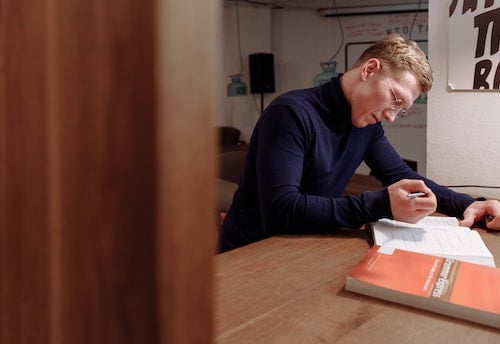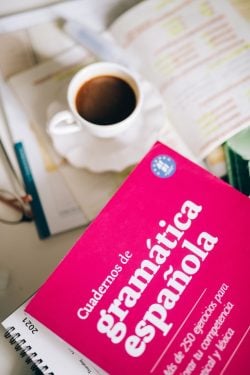The 4 Most Used Verb Tenses In Spanish
As a Spanish teacher, I’ve noticed that as soon as you write “Verb Tenses in Spanish” on the board, English speakers start shivering. But, is Spanish grammar all that difficult?
Well, that all depends on your level of Spanish. If you’re just starting to learn the language, then yes, there are certainly some tricky grammar rules to get your head around. But once you’ve mastered the basics, you will see that verb tenses in Spanish are actually quite straightforward – and even simpler than their English counterparts in some ways!
→Sign Up Now: Free Trial Spanish Lesson With a Native Teacher!←
For example, the number of irregular verbs in Spanish is relatively small compared to English. This means that once you’ve learned the basics of conjugation patterns in Spanish, you’re well on your way to mastering the verb tenses!
So, without further ado, let’s take a closer look at the 4 most used tenses in Spanish, how they are used and when to use them…
Present Simple
The present simple tense is one of the most basic and commonly used tenses in Spanish. It can be used for a lot of different language functions:
States: Mi hermana es alta. (My sister is tall.)
Habitual actions: Yo trabajo en una tienda. (I work in a shop.)
Routines: Los niños van al colegio a las ocho. (The children go to school at 8 am.)
Future actions: Mañana viene mi madre de visita. (My mother is coming for a visit tomorrow.)
How is the present simple formed in Spanish?
In Spanish, the present simple is usually formed by adding:
–o to regular verbs in the first person singular (yo)
-as or –es for the second person singular (tú)
-a or -e for the third person singular (él/ella)
-amos, -emos or -imos for the first person plural ().
-áis, -éis or -ís for the second person plural as used in Spain (vosotros)
-an or -en for the second person plural as used in Latin America (ustedes)
-an or -en for the third person plural (ellos)
Notice that Latin American countries and Spain use different pronouns for the second person plural form. While the Spanish “vosotros” takes a special conjugation, the Latin American form, “ustedes”, has the same conjugation as the third person plural, “ellos”, as can be seen in the following examples:

Hablar (to speak)
Singular: yo hablo, tú hablas, él/ella/ habla
Plural: nosotros hablamos, vosotros habláis / ustedes hablan ellos hablan
Comer (to eat)
Singular: yo como, tú comes, él/ella/ come
Plural: nosotros comemos, vosotros coméis / ustedes comen, ellos comen
Vivir (to live)
Singular: yo vivo, tu vives, él/ella/ vive
Plural: nosotros vivimos, vosotros vivís / ustedes viven ellos viven
In Spanish, infinitive verbs end in -ar, -er, or -ir. And, as you can see in the examples above, it is this ending that helps you predict conjugation.
But be careful. There are some irregular verbs in the present simple too. These include ser (to be), ir (to go), ver (to see), hacer (to do)… and some others. These irregular verbs must be learned by heart as they don’t follow the regular conjugation rules. For example:
Ser (to be)
Singular: yo soy, tú eres, él/ella/ es
Plutal: nosotros somos, ustedes son (Latin America) / vosotros sois (Spain), ellos son
Ir (to go)
Singular: yo voy, tú vas, él/ella/ va
Plural: nosotros vamos, ustedes van (Latin America) / vosotros vais (Spain), ellos van
Ver (to see)
Singular: yo veo, tú ves, él/ella/ ve
Plural: nosotros vemos, ustedes ven (Latin America) / vosotros veis (Spain), ellos ven
Hacer (to do)
Singular: yo hago, tú haces, él/ella/ hace
Plural: nosotros hacemos, ustedes hacen (Latin America) / vosotros hacéis (Spain), ellos hacen
Since the present simple is mainly used to talk about habitual activities and routines, you will often see the following time expressions attached to phrases expressed in this tense: siempre (always), normalmente (normally), usualmente (usually), a veces (sometimes), nunca (never).
Present Continuous
The present continuous is used to describe actions that are happening now or around now. It’s the equivalent of the English ‘I am doing…’, ‘you are doing…’, ‘he is doing…’ etc. For example:
Ahora estoy leyendo un libro. (I’m reading a book now.)
Estás estudiando mucho últimamente. (You’re studying a lot lately.)
Mis hermanos están jugando en su habitación. (My siblings are playing in their room.)
How is the present continuous formed in Spanish?
The present continuous tense is made up of two parts: the present tense of the verb estar (to be) and a present participle. The present participle is formed by taking the infinitive of the main verb and adding -ndo for regular verbs (-iendo for verbs that end in -ir).

As in English, the most difficult part of continuous tenses in Spanish is remembering the conjugation of the verb ‘be’ (estar) for every person.
Read these examples carefully so you can start familiarizing yourself with these forms:
Hablar (to speak)
yo estoy hablando, tú estás hablando, él/ella/usted está hablando, nosotros estamos hablando
Comer (to eat)
yo estoy comiendo, tú estás comiendo, él/ella/usted está comiendo, nosotros estamos comiendo, ustedes están comiendo/vosotros estáis comiendo, ellos están comiendo
Beber (to drink)
yo estoy bebiendo, tú estás bebiendo, él/ella/usted está bebiendo, nosotros estamos bebiendo, ustedes están bebiendo/vosotros estás bebiendo, ellos están bebiendo
Since the present continuous is used to talk about things happening at the moment or around the present moment, you will often see these time expressions next to continuous phrases: ahora (now) ahora mismo (right now), en este momento (in this moment), últimamente (lately).
Past simple
The past simple is used to describe completed actions in the past, i.e., things that started and finished in the past. It’s the equivalent of the English ‘I did…’, ‘you saw…’, ‘he spoke…’ etc.
For example:
Ayer compré un bolso nuevo. (Yesterday I bought a new handbag.)
Ella vio a sus amigos en el cine. (She saw her friends at the cinema.)
Nosotros fuimos a la playa después de comer. (We went to the beach after eating.)
How is the past simple formed in Spanish?
The past simple is usually formed by taking the regular verb in its infinitive form and removing the ending (-ar, -er, -ir) to leave the stem. This stem is then conjugated according to:
- the ending of the infinitive verb: -ar, -er, or -ir
- who is doing the action
Regular verbs ending in -ar:
Hablar (to speak)
yo hablé, tú hablaste, él/ella/usted habló, nosotros hablamos, vosotros hablasteis/ustedes hablaron, ellos hablaron.
Matar (to kill)
yo maté, tú mataste, él/ella/usted mató, nosotros matamos, vosotros matasteis/ustedes mataron, ellos mataron.
Regular verbs ending in -er:
Comer (to eat)
yo comí, tú comiste, él/ella/usted comió, nosotros comimos, vosotros comisteis/ustedes comieron, ellos comieron
Leer (to read)
yo leí, tú leíste, él/ella/usted leyó, nosotros leímos, vosotros leísteis/ustedes leyeron, ellos leyeron
Regular verbs ending in -ir:
Escribir (to write)
yo escribí, tú escribiste, él/ella/usted escribió, nosotros escribimos, vosotros escribisteis/ustedes escribieron, ellos escribieron
Abrir (to open)
yo abrí, tú abriste, él/ella/usted abrió, nosotros abrimos, vosotros abristeis/ustedes abrieron, ellos abrieron
As you can see from the examples above, the stems of regular verbs have different terminations depending on the pronoun they are attached to and the ending of their infinitive form. However, there are some irregular verbs that don’t follow this rule and they must be learned by heart.
The most common irregular verbs in the past simple are:
- ser (to be): yo fui, tú fuiste, él/ella/usted fue, nosotros fuimos, vosotros fuisteis/ustedes fueron, ellos fueron
- tener (to have): yo tuve, tú tuviste, él/ella/usted tuvo, nosotros tuvimos, vosotros tuvisteis/ustedes tuvieron, ellos tuvieron.
- hacer (to do): yo hice, tú hiciste, él/ella/usted hizo, nosotros hicimos, vosotros hicisteis/ustedes hicieron, ellos hicieron
- decir (to say): yo dije, tú dijiste, él/ella/usted dijo, nosotros dijimos, vosotros dijisteis/ustedes dijeron, ellos dijeron
- ver (to see): yo vi, tú viste, él/ella/usted vio, nosotros vimos, vosotros visteis/ustedes vieron, ellos vieron
- ir (to go): yo fui, tú fuiste, él/ella/usted fue, nosotros fuimos, vosotros fuisteis/ustedes fueron, ellos fueron
- poder (to be able to): yo pude, tú pudiste, él/ella/usted pudo, nosotros pudimos
Since the past simple is used to talk about finished actions and situations, you will often find it next to phrases such as ayer (yesterday), la semana pasada (last week), and hace dos años (two years ago).
Future with ir a + an infinitive verb (Be going to)

The verbal expression ir a + infinitive allows us to express a statement with a sense of the future in the present. This construction is often used in spoken Spanish to express a planned action or something that will happen soon. It is one of the most common tenses in Spanish, and the most used future tense in most Spanish-speaking countries, even more than the future simple (whose English equivalent with be the one with ‘will’)
For example:
El viernes voy a salir con mis amigos. (On Friday I’m going out with my friends.)
Mi hermano va a comprar un coche nuevo. (My brother is going to buy a new car.)
Vamos a ir al cine esta noche. (We’re going to go to the cinema tonight.)
How is the ‘be going to’ tense in Spanish formed?
The ‘be going to’ tense in Spanish is formed with the expression ir a (conjugated accordingly for each person) + an infinitive verb:
Yo voy a limpiar (I’m going to clean)
Tú vas a limpiar (You’re going to clean)
Él/Ella va a limpiar (He/she is going to clean)
Nosotros vamos a limpiar (We’re going to clean)
Vosotros vais a limpiar (You all are going to clean) (Spain)
Ustedes van a limpiar (You all are going to clean) (Latin America)
Ellos van a limpiar (They’re going to clean)
If you are talking about the future, make sure to add precision to your sentences by adding time expressions such as mañana (tomorrow), esta noche (tonight), el martes (on Tuesday), and el mes que viene (next month).
So, there you go. These are the most common tenses in Spanish. With them, you will be able to communicate your ideas, communicate your plans, talk about your habits and past experiences, and express your feelings. We hope you find this guide useful and that it will help you improve your Spanish skills!
→Sign Up Now: Free Trial Spanish Lesson With a Native Teacher!←
If you want to go beyond tenses in Spanish and start sharpening your conversational skills, send us a quick message telling us all about your learning goals so that we can find you the best match among our pool of native Spanish teachers.
